Martin Beeh
Martin Beeh is a graduate in Industrial Design from Darmstadt University of Applied Sciences in Germany and the ENSCI-Les Ateliers, Paris, and completed a postgraduate course in business administration. In 1995, he
became design coordinator at Décathlon in Lille, France, in 1997 senior designer at Electrolux Industrial Design Center Nuremberg and Stockholm, and furthermore became design manager at Electrolux Industrial Design Center Pordenone, Italy, in 2001. He is a laureate of several design awards as well as the founder and director of the renowned student design competition “Electrolux Design Lab”. In 2006, he became general manager of the German office of the materials library Material ConneXion in Cologne. Three years later, he founded the design office beeh_innovation. Martin Beeh lectured at the Folkwang University of the Arts in Essen, the University of Applied Sciences
Schwäbisch Gmünd and the University of Applied Sciences Hamm-Lippstadt, and was professor for design management at the University of Applied Sciences Ostwestfalen-Lippe in Lemgo from 2012 to 2015. He has furthermore developed the conference format “materials.cologne” as a dialogue platform for materials, design and innovation.

Red Dot in an interview with Martin Beeh
In your work as a designer, you have an intensive relationship with materials. Are there any material developments that you find particularly fascinating?
If the product marketing activities of many companies are anything to go by, the use of recycled materials is all the rage at the moment. That’s certainly a positive development in terms of the CO2 footprint and resource efficiency, but it doesn’t necessarily make the newly created product recyclable.
Why is that?
Mixed material items are often very difficult, if not impossible, to separate into single-origin components for recycling. This actually only delays the point in time when the items are thrown away. Activities related to the development of materials, production and products should focus on monomaterials and on materials that can be effectively separated, either industrially or by the consumer. As an industrial designer, I’m fascinated to see all the new possibilities arising as a result of cradle-to-cradle product development processes. New aesthetics, new applications, new longevity of the products and their effective reintroduction into the materials cycle at the end of their lifespan – this is what we need for a successful new start. Almost daily I’m hearing about new products that are developed and marketed according to the circularity principle. Many things are already possible from a purely technical and design perspective. I believe that the retail sector and user acceptance will be key. Manufacturers should be proactive in promoting circularity as the “new normal” in their industries.
Plastics are often demonised. Is that unfair?
Definitely. When I was working as a co-author on a book called “Kunststoffe im Kreislauf” (Plastics Recycling) with Peter Orth, Manfred Rink and Jürgen Bruder (published by Springer Vieweg), I learned a lot of new things about plastic. Their potential is far from being exhausted, and many clever and courageous individuals have already made significant progress in this area. Some of the most exciting material-related topics for me right now involve the recyclability and processing of plastics, as well as high-performance natural fibres, lightweight materials and composites.
What role does the feel of a product play in this “age of screens”?
Even in the age of screens we touch a lot of IT devices, which tells us something about their quality, even though we aren’t always aware of it. That’s obvious when you consider all the hype surrounding iPhones and other premium smartphones or game consoles. Augmented and virtual reality are also opening up an entirely new world of digital haptics.
There’s a close link between materials and sustainability. How can product designers contribute to making our world a little more eco-friendly?
Product designers need to be involved at a very early stage in the process, so they can contribute their breadth of know-how and expertise. They need to gain knowledge of the materials, how they are processed, their sustainable qualities and their recyclability. User-friendliness is an aspect of long-lasting design, and it encourages the respectful handling of the products. Design for repair is another essential characteristic that is creating new business segments related to product service systems. Also, perhaps we should think about designing fewer products, but making them better – in collaboration with clients and retailers.
You studied both industrial design and business administration. To what extent can economic thinking inspire creativity?
Design management is the interface between industrial design and business administration. Fortunately, I have been able to learn and practise this in major international enterprises. Being an ambassador at the place where the two worlds meet allows me to be creative, but with an awareness of the necessity for economic efficiency. Integrating creativity in economic processes is still the exception to the rule. Unfortunately, linear, repetitive thinking and optimising what already exists is still the predominant practice in an industrial setting. And that’s a major obstacle to game-changing innovation. So let’s have more good design and design management! There’s still plenty of potential – particularly when it comes to sustainability – to create really good products and services for credible brands.
Are there any product segments you’re really passionate about?
Household appliances, everyday kitchen objects, (mechanical) bicycles, trains, technical textiles, mountain sports equipment and technical sports shoes. That sounds like my CV and a list of my hobbies.
What is innovative design for you?
Always being a step ahead. The creation of something inconceivable that nobody expected.